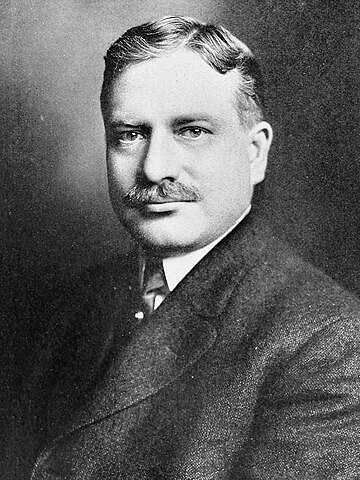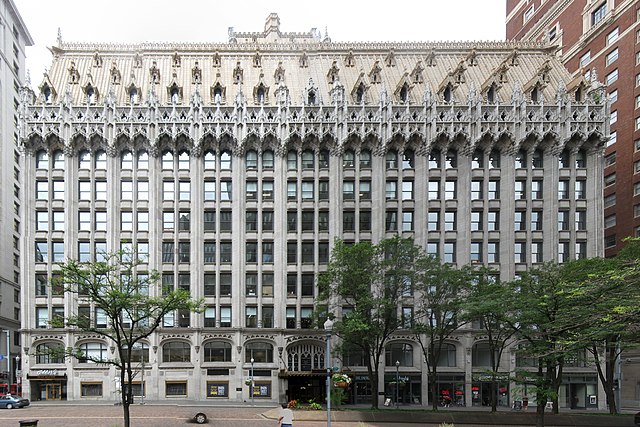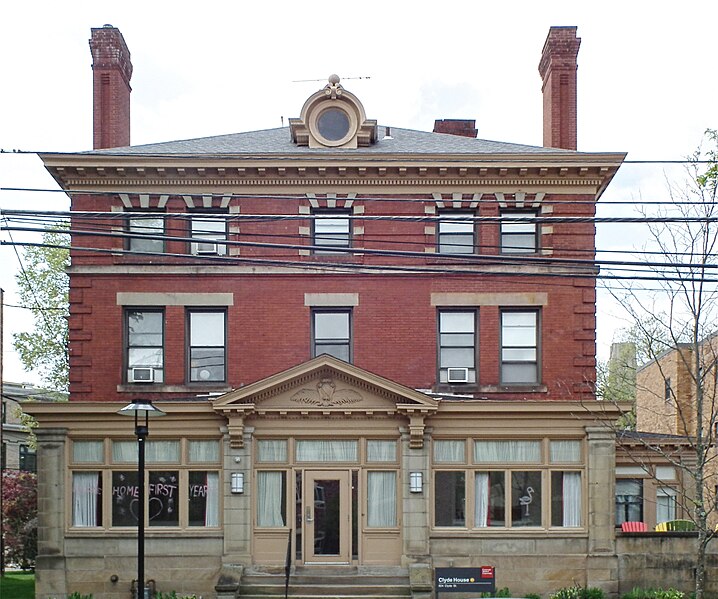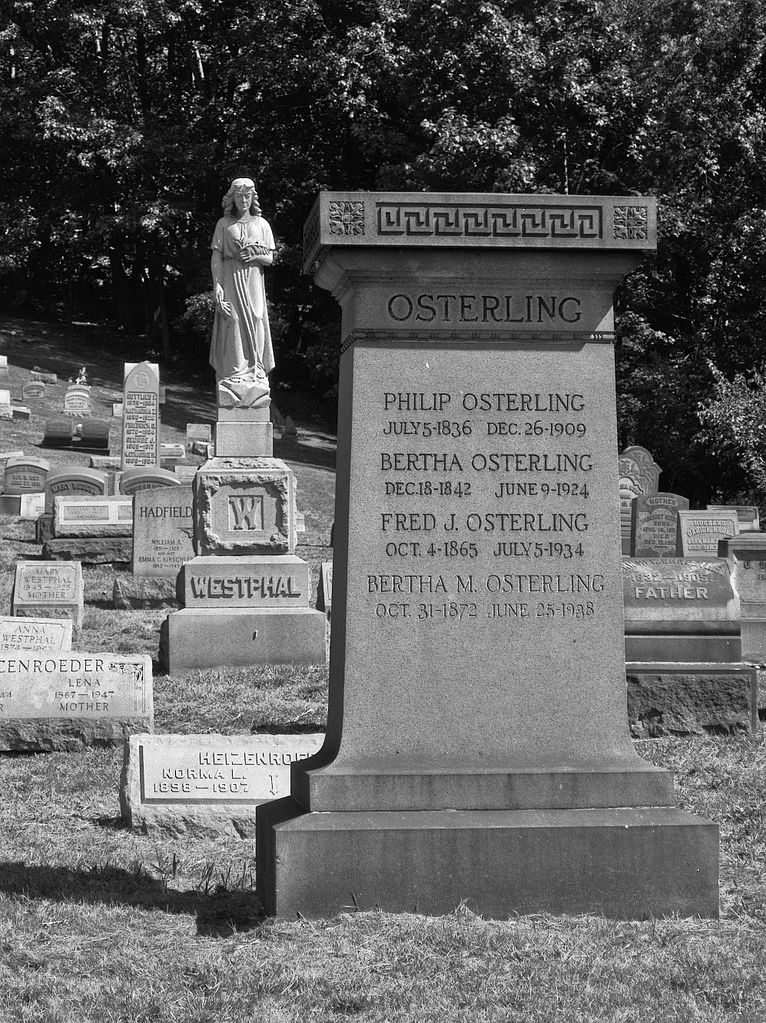Frederick Osterling

Frederick Osterling, from Prominent Pennsylvanians, 1913
Arrott Building
Frederick Osterling was one of our most versatile and imaginative architects. He worked in many different styles, but there is a certain tasteful flamboyance in everything he has left us that marks it as Osterling’s work. Earlier in his career, he could produce a Richardsonian Romanesque that could out-Richardson Richardson; but he could also work in Gothic, classical, Flemish, or any other style you liked.
Times Building
Union Trust Building
Osterling was one of Henry Clay Frick’s favorite architects, and he designed the complete remodeling of Frick’s home Clayton. Later, Frick turned against him, and Frick was the sort who insisted on completely ruining his adversaries. Osterling’s large commissions downtown ceased. On the other hand, it seems he didn’t really need to work: when he died in 1934, Osterling left an estate valued at a million dollars, which was a good bit of money in those days.
The Iroquois
An incomplete list of his works:
Allegheny County Morgue, 542 Fourth Avenue, 1901
Allegheny High School, Allegheny Center, 810 Arch Street, 1904
Amstrong Cork Co. factory, Strip, 2349 Railroad Street, 1901/1913
Arrott Building, Downtown, Fourth Avenue and Wood Street, 1902
Bell Telephone Building, Seventh Avenue and Montour Way, 1890
Bellefield Presbyterian Church, Oakland, Fifth Avenue and Dithridge Street, 1889 (demolished except for the tower)
Carnegie Free Library of Beaver Falls, Beaver Falls, 1301 Seventh Avenue, 1899
Charles Schwab House, North Braddock, 541 Jones Avenue, 1893
Chautauqua Lake Ice Company (Heinz History Center), Strip, 1212 Smallman Street, 1898
Clayton remodeling, Point Breeze, 7200 Penn Avenue, 1870s
Colonial Trust Company, Fourth Avenue and Wood Street, 1902
Commonwealth Trust Building, 316 Fourth Avenue, 1906
First Methodist Church (Korean Central Church of Pittsburgh), Shadyside, 821 South Aiken Avenue, 1893
Hillsdale School, Dormont, Hillsdale Avenue, 1912
Houses at 3603–3607 California Avenue, Brighton Heights
Iroquois Building, Oakland, 3600-3620 Forbes Avenue, 1901–1903
James H. Hammond House (Clyde House), Shadyside, 624 Clyde Street, before 1904
Marine Bank Building, Smithfield Street and Third Avenue
Negley-Gwinner-Harter House renovations, Shadyside, Fifth Avenue and Amberson Avenue
Osterling architectural studio, North Shore, 228 Isabella Street, 1910s
Times Building, Downtown, Fourth Avenue and Third Avenue
Union Trust Building, Downtown, Grant Street and Fifth Avenue, 1917
Vanadium Building (Parkvale Building), Oakland, Forbes Avenue and Meyran Avenue, 1911
Washington County Courthouse, 1900
Washington County Jail, 1900
Washington Trust Building, Washington (Pa.), 6 South Main Street, 1902–1903
Westinghouse Air Brake Company Administrative Building (The Castle), Wilmerding, 1890
For a longer list, see Father Pitt’s Great Big List of Buildings and Architects, which is kept up to date with old Pa Pitt’s latest research.
James H. Hammond House
Osterling is buried with his parents and his unmarried sister in the Rosedale Cemetery in Ross Township.
A long biography of Osterling was printed in History of Pittsburgh and Environs by George Thornton Fleming (New York: American Historical Society, Inc., 1922), Vol. 5, p. 60. We include the whole article here.
FREDRICK JOHN OSTERLING—The master minds which give to the world symmetry and beauty, expressed in enduring forms, bear a part in the very creation of the world. Frederick John Osterling, the leading architect of Pittsburgh, Pa., and one of the foremost men in his line in all the East, has combined the genius of the master mind with the thorough practicability of the utilarian in the many structures which he has designed here and elsewhere. Mr. Osterling’s lifestory is of interest to every one for whom the history of Pittsburgh holds interest.
Philip Osterling, father of Frederick J. Osterling, came to old Allegheny when he was only eleven years of age, and during his lifetime was in the building trades, first as carpenter and later as builder. He served during the Civil War with a "St. Louis" Volunteer Regiment, and returned to Pittsburgh at the close of the war. He died Dec. 26, 1909. He married Bertha Stauffer, who was born in Zelienople, Pa. The Stauffer family is a very old one in Pennsylvania, having been in Butler county for generations, and are believed to be among the earliest pioneers. Mr. Osterling’s mother is still living, in her seventy-ninth year. Of the five children, the other son, Daniel P., resides in Cleveland, Ohio, and has large quarry interests there; two daughters are living : Bertha M., residing at home ; and Annetta E., being the wife of John H. Axtell, of Spartanburg, S. C. Elizabeth died at the age of eleven years.
Frederick John Osterling was born in Devosburg [Dravosburg], Allegheny county, Pa., Oct. 4, 1865. He received his early education in the old Sixth Ward schools of old Allegheny, now a part of Pittsburgh, then attended the I.essing Institute, in old Allegheny. As the boy approached manhood and looked forward to his own future, his only interest was in architecture. Turning to the study of this art, first as a favorite pastime, then later with a definite ambition, he achieved material progress by self study. When he had completed his formal education, he entered the offices of Joseph Stillberg, a prominent architect of that day. In this connection he gained not only valuable experience, but cordial encouragement. He showed such marked adaptability for the work that he was urged to go abroad and study the architecture of Europe. Accordingly he spent more than a year in Europe, to this end, and has since made other trips abroad for the same purpose, besides visiting every celebrated point in the United States for the study of this art. Upon his first return from Europe, Mr. Osterling promptly entered the field for himself. He won his first work in open competition, and it was a large and important contract — the Allegheny (now Pittsburgh) High School. This was the Sherman street building, and he later had the contract for the Arch street addition. The building now occupies an entire city block. By this beginning in big work Mr. Osterling leaped at once into prominence. He has designed most of the large buildings in Pittsburgh, and his services have been sought far and wide.
Of all his work the Union Arcade, of which H. C. Frick is owner, is perhaps the most striking. It is considered one of the finest and most ornate office buildings in this country. Among other office buildings which bear the stamp of Mr. Osterling’s ability are: The East End Savings and Trust Company building, the Vanadium building, the Commonwealth Trust Company building, the Arrott building, and the Magee building. Many beautiful church edifices are counted among his achievements, including the Bellefield Presbyterian, the First Methodist, and the Manchester Presbyterian, of Pittsburgh, and St. Thomas Roman Catholic, of Braddock, and St. Peter’s, of Loretta, Pa. He has designed public buildings in many parts of the State, some of the most noteworthy being the Luzerne County Court House, Wilkes-Barre; the Washington County Court House, Washington; the State Institution for Feeble-Minded, of Western Pennsylvania, at Polk, Venango county; the Allegheny Hospital for the Insane, Woodville; the hospital buildings for the City of Pittsburgh, Marshalsea; the dining room and service buildings at the Dixmont Hospital for the Insane, the Carnegie Library, Beaver Falls; and the Allegheny County Mortuary and Allegheny County Jail, Pittsburgh. Of his residential work the following beautiful Pittsburgh homes are representative: That of Thomas Morrison, on Highland avenue, of H. C. Frick, Penn and Homewood avenues, of D. H. Hostetter, on Fifth avenue, of C. D. Armstrong, on Lexington avenue, of George M. Von Bonnhorst, of Ingram, and of the Hon. R. S. Frazer, on Shady avenue, Pittsburgh. Of industrial buildings from Mr. Osterling’s designs, there are a goodly number in Pittsburgh and vicinity, including the Armstrong Cork Company warehouse; the American Vanadium Company, Bridgeville; the Consolidated Ice Company, Pittsburgh; the L. Vilsack warehouse; the Haugh & Keenan Storage & Transfer Company’s building; Campbell’s Department Store, and an important portion of the plant of the Westinghouse Airbrake Company, Wilmerding, Pa.
Perhaps, however, the work which has attracted the widest attention, and which will be of most lasting interest to the citizens of Pittsburgh, is standing in the schools of Pittsburgh and its environs. Besides the Allegheny High School, which, as above noted, was his first work, Mr. Osterling designed the North Public School, Duquesne Way; the Dormont Public School, Dormont; the Eleventh Ward Public School, known as the Horace Mann School, at the corner of Shadeland avenue and Eckert street; the Sunnyside Public School, at the corner of McCandless avenue and Fifty-sixth street; the Oakmont Public School, Oakmont; the Thaddeus Stevens Public School, on Main street, West End; and the Sacred Heart Roman Catholic School, on Center avenue.
Mr. Osterling’s work includes, in almost every instance, the oversight of the entire construction of his buildings, and he sometimes has as many as six hundred workmen busy under his direction. His own office building, which he constructed in 1917, containing his offices, drafting rooms, etc., and occupied entirely by himself and his assistants, is a wonderful example of modern compactness, and a structure of rare beauty and symmetry.
Mr. Osterling’s interests center in his business, and he has no hobby but work. He achieved his present high position entirely by his own efforts, and may well be congratulated upon having realized his cherished ambition to a degree rare in a world of struggle and competition.
Fraternally, Mr. Osterling is prominent, holding the thirty-second degree in the Masonic order, and being a member of all the Masonic bodies. He is also a member of the Fraternal Order of Eagles, and of the United Order of American Mechanics. He is an influential and honored member of the Pennsylvania State Architecture Association. Politically, he reserves the right to individual decision, in local affairs, with which he keeps in close touch, but supports the Republican party in matters of national import. He has often been sought as a candidate for public office, but has thus far consistently declined to accept political honors. He is a member of the Pittsburgh Athletic Club, and of the Union Club. He has never married, and his church membership is with the Smithfield Methodist Episcopal Church.





